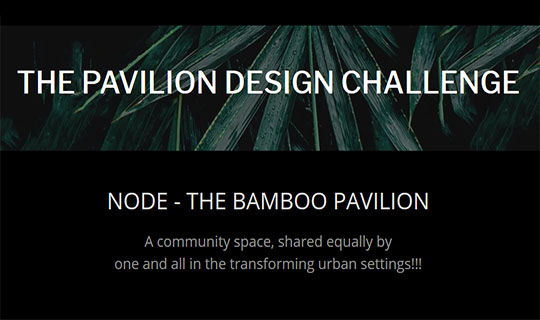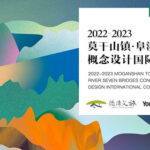Submission: December 27, 2020
Registration: December 06, 2020
Language: English
Location: Concept
Prizes: INR 50000 + Intership Opportunities + Publication & Best
Type: Open
The competition is to design a pavilion – a community space, that can be shared equally by one and all in the transforming urban settings. It could be a new refuge, an inspiring and calming breather!
The pavilion can be a place catering to various urban activities; where it can become a place to relax and to wander in, a small community space for to gather, discuss and even loiter. to be built using sustainable building material like bamboo.
NODE – The pavilion, a community space, is shared equally by one and all in the transforming urban settings. It is a new refuge, an inspiring and calming breather! Node can be interpreted based on its context, it can be a place catering to various urban activities; where it can become a place to relax and to wander in, a small community
space for to gather, discuss and even loiter. A pause in the chaotic city or simply becoming a hangout/gathering place during in the mornings and the evenings. Node can blend in with the context or stand out, but the primary function should be evocative of being a public space. It having a sense of community, the NODE should be easy to realise. Could it be participatory in process?
Another objective of this design challenge is to raise the awareness of bamboo as a sustainable building material. Participants have to leverage bamboo as the primary material in reconfiguring the public space, by creating a communion with the site and its surroundings. On one hand, it prompts the ephemeral and on the other, the memorial of a community spirit.
The Node should symbolise the human hope and dream of the sustainable and eco-friendly future – offering a more habitable environment. and In spirit, it is the giving back of the community spaces to our next generation, leveraging sustainable building materials like bamboo highlighting the intimate relationship between human beings and nature. Its form, workmanship and details are assuming that there is a certain life to the structures in bamboo.
However, the proposed design would inspire the future generations of the community to make architecture of bamboo as a reoccurring phenomenon of ecological conception.
Site selection:
For this design project, individual as well as team entries are welcome. The designer/designers are allowed to pick a suitable site that they find fit for their design proposal. As the competition focuses more on the technical and structural aspects of bamboo, participants should equally emphasise the form, the structure and the details.
The following parameters need to be considered while selecting a site:
- The site should be an open space and located in India
- The selected site should be within the urban context, and in proximity to residential/commercial neighbourhoods which can be easily accessed by anyone and everyone
- The site area cannot exceed 50 sq.m (built-up area is restricted to 36 sq.m)
- Justification for the selected site should be evident in site analysis and the design response.
Function:
Aim of the pavilion is to make socially inclusive space evocative of new or transformed urban character; hence the daily, weekly and periodic activities or uses in response to the context of the site. The design-justification lies in the possible success of the programme.
Requirements:
- The max buildable area – 36 sq.m (including the overhangs and projections)
- The height of the pavilion should not exceed 6 meters.
- The structure must be freestanding and cannot be an extension of any existing building. built.
- The long-term durability of the structural members is expected and they must be easily replaceable.
- Appropriate lighting to be considered for its night time use.
Judging Criteria:
- Concept and design
- Originality of design
- Aesthetics, functionality & durability
- Innovative use of materials and construction techniques
- Practicality, feasibility and buildability of the pavilion.








